- Home
- Jared Diamond
The World Until Yesterday: What Can We Learn From Traditional Societies?
The World Until Yesterday: What Can We Learn From Traditional Societies? Read online
THE
WORLD
UNTIL
YESTERDAY
ALSO BY JARED DIAMOND
Collapse
Guns, Germs, and Steel
Why Is Sex Fun?
The Third Chimpanzee
JARED DIAMOND
THE
WORLD
UNTIL
YESTERDAY
WHAT CAN WE LEARN
FROM TRADITIONAL SOCIETIES?
VIKING
VIKING
Published by the Penguin Group
Penguin Group (USA) Inc., 375 Hudson Street, New York, New York 10014, U.S.A.
Penguin Group (Canada), 90 Eglinton Avenue East, Suite 700, Toronto, Ontario M4P 2Y3, Canada
(a division of Pearson Penguin Canada Inc.)
Penguin Books Ltd, 80 Strand, London WC2R 0RL, England
Penguin Ireland, 25 St. Stephen’s Green, Dublin 2, Ireland (a division of Penguin Books Ltd)
Penguin Group (Australia), 707 Collins Street, Melbourne, Victoria 3008, Australia
(a division of Pearson Australia Group Pty Ltd)
Penguin Books India Pvt Ltd, 11 Community Centre, Panchsheel Park, New Delhi – 110 017, India
Penguin Group (NZ), 67 Apollo Drive, Rosedale, Auckland 0632, New Zealand
(a division of Pearson New Zealand Ltd)
Penguin Books, Rosebank Office Park, 181 Jan Smuts Avenue, Parktown North 2193, South Africa
Penguin China, B7 Jaiming Center, 27 East Third Ring Road North, Chaoyang District,
Beijing 100020, China
Penguin Books Ltd, Registered Offices: 80 Strand, London WC2R 0RL, England
First published in 2012 by Viking Penguin, a member of Penguin Group (USA) Inc.
1 3 5 7 9 10 8 6 4 2
Copyright © Jared Diamond, 2012
All rights reserved
Photograph credits appear on page 499.
LIBRARY OF CONGRESS CATALOGING IN PUBLICATION DATA
Diamond, Jared M.
The world until yesterday : what can we learn from traditional societies? / Jared Diamond.
p. cm.
Includes bibliographical references and index.
ISBN: 978-1-101-60600-1
1. Dani (New Guinean people)—History. 2. Dani (New Guinean people)—Social life and customs. 3. Dani (New Guinean people)—Cultural assimilation. 4. Social evolution—Papua New Guinea. 5. Social change—Papua New Guinea. 6. Papua New Guinea—Social life and customs. I. Title.
DU744.35.D32D53 2013
305.89’912—dc23
2012018386
Designed by Nancy Resnick
Maps by Matt Zebrowski
No part of this book may be reproduced, scanned, or distributed in any printed or electronic form without permission. Please do not participate in or encourage piracy of copyrighted materials in violation of the author’s rights. Purchase only authorized editions.
ALWAYS LEARNING PEARSON
To
Meg Taylor,
in appreciation for decades
of your friendship,
and of sharing your insights into our two worlds
Contents
Also by Jared Diamond
Title Page
Copyright
Dedication
List of Tables and Figures
PROLOGUE: At the Airport
An airport scene
Why study traditional societies?
States
Types of traditional societies
Approaches, causes, and sources
A small book about a big subject
Plan of the book
PART ONE: SETTING THE STAGE BY DIVIDING SPACE
CHAPTER 1. Friends, Enemies, Strangers, and Traders
A boundary
Mutually exclusive territories
Non-exclusive land use
Friends, enemies, and strangers
First contacts
Trade and traders
Market economies
Traditional forms of trade
Traditional trade items
Who trades what?
Tiny nations
PART TWO: PEACE AND WAR
CHAPTER 2. Compensation for the Death of a Child
An accident
A ceremony
What if…?
What the state did
New Guinea compensation
Life-long relationships
Other non-state societies
State authority
State civil justice
Defects in state civil justice
State criminal justice
Restorative justice
Advantages and their price
CHAPTER 3. A Short Chapter, About a Tiny War
The Dani War
The war’s time-line
The war’s death toll
CHAPTER 4. A Longer Chapter, About Many Wars
Definitions of war
Sources of information
Forms of traditional warfare
Mortality rates
Similarities and differences
Ending warfare
Effects of European contact
Warlike animals, peaceful peoples
Motives for traditional war
Ultimate reasons
Whom do people fight?
Forgetting Pearl Harbor
PART THREE: YOUNG AND OLD
CHAPTER 5. Bringing Up Children
Comparisons of child-rearing
Childbirth
Infanticide
Weaning and birth interval
On-demand nursing
Infant-adult contact
Fathers and allo-parents
Responses to crying infants
Physical punishment
Child autonomy
Multi-age playgroups
Child play and education
Their kids and our kids
CHAPTER 6. The Treatment of Old People: Cherish, Abandon, or Kill?
The elderly
Expectations about eldercare
Why abandon or kill?
Usefulness of old people
Society’s values
Society’s rules
Better or worse today?
What to do with older people?
PART FOUR: DANGER AND RESPONSE
CHAPTER 7. Constructive Paranoia
Attitudes towards danger
A night visit
A boat accident
Just a stick in the ground
Taking risks
Risks and talkativeness
CHAPTER 8. Lions and Other Dangers
Dangers of traditional life
Accidents
Vigilance
Human violence
Diseases
Responses to diseases
Starvation
Unpredictable food shortages
Scatter your land
Seasonality and food storage
Diet broadening
Aggregation and dispersal
Responses to danger
PART FIVE: RELIGION, LANGUAGE, AND HEALTH
CHAPTER 9. What Electric Eels Tell Us About the Evolution of Religion
Questions about religion
Definitions of religion
Functions and electric eels
The search for causal explanations
Supernatural beliefs
Religion’s function of explanation
Defusing anxiety
Providing comfort
Organization and obedience
Codes of behavior towards strangers
Justifying war
Badges of commitment
Measures of religious success
Changes in religion’s functions
CHAPTER 10. Speaking in Many Tongues
Multilingualism
The world’s language total
How languages evolve
Geography of language diversity
Traditional multilingualism
Benefits of bilingualism
Alzheimer’s disease
Vanishing languages
How languages disappear
Are minority languages harmful?
Why preserve languages?
How can we protect languages?
CHAPTER 11. Salt, Sugar, Fat, and Sloth
Non-communicable diseases
Our salt intake
Salt and blood pressure
Causes of hypertension
Dietary sources of salt
Diabetes
Types of diabetes
Genes, environment, and diabetes
Pima Indians and Nauru Islanders
Diabetes in India
Benefits of genes for diabetes
Why is diabetes low in Europeans?
The future of non-communicable diseases
EPILOGUE: At Another Airport
From the jungle to the 405
Advantages of the modern world
Advantages of the traditional world
What can we learn?
Acknowledgments
Further Readings
Index
Illustration Credits
Photo Insert
List of Tables and Figures
Figure 1 Locations of 39 societies that will be discussed frequently in this book
Table 1.1 Objects traded by some traditional societies
Table 3.1 Membership of two warring Dani alliances
Table 8.1 Causes of accidental death and injury
Table 8.2 Traditional food storage around the world
Table 9.1 Some proposed definitions of religion
Table 9.2 Examples of supernatural beliefs confined to particular religions
Figure 9.1 Religion’s functions changing through time
Table 11.1 Prevalences of Type-2 diabetes around the world
Table 11.2 Examples of gluttony when food is abundantly available
PROLOGUE
At the Airport
An airport scene Why study traditional societies? States Types of traditional societies Approaches, causes, and sources A small book about a big subject Plan of the book
An airport scene
April 30, 2006, 7:00 A.M. I’m in an airport’s check-in hall, gripping my baggage cart while being jostled by a crowd of other people also checking in for that morning’s first flights. The scene is familiar: hundreds of travelers carrying suitcases, boxes, backpacks, and babies, forming parallel lines approaching a long counter, behind which stand uniformed airline employees at their computers. Other uniformed people are scattered among the crowd: pilots and stewardesses, baggage screeners, and two policemen swamped by the crowd and standing with nothing to do except to be visible. The screeners are X-raying luggage, airline employees tag the bags, and baggage handlers put the bags onto a conveyor belt carrying them off, hopefully to end up in the appropriate airplanes. Along the wall opposite the check-in counter are shops selling newspapers and fast food. Still other objects around me are the usual wall clocks, telephones, ATMs, escalators to the upper level, and of course airplanes on the runway visible through the terminal windows.
The airline clerks are moving their fingers over computer keyboards and looking at screens, punctuated by printing credit-card receipts at credit-card terminals. The crowd exhibits the usual mixture of good humor, patience, exasperation, respectful waiting on line, and greeting friends. When I reach the head of my line, I show a piece of paper (my flight itinerary) to someone I’ve never seen before and will probably never see again (a check-in clerk). She in turn hands me a piece of paper giving me permission to fly hundreds of miles to a place that I’ve never visited before, and whose inhabitants don’t know me but will nevertheless tolerate my arrival.
To travelers from the U.S., Europe, or Asia, the first feature that would strike them as distinctive about this otherwise familiar scene is that all the people in the hall except myself and a few other tourists are New Guineans. Other differences that would be noted by overseas travelers are that the national flag over the counter is the black, red, and gold flag of the nation of Papua New Guinea, displaying a bird of paradise and the constellation of the Southern Cross; the counter airline signs don’t say American Airlines or British Airways but Air Niugini; and the names of the flight destinations on the screens have an exotic ring: Wapenamanda, Goroka, Kikori, Kundiawa, and Wewak.
The airport at which I was checking in that morning was that of Port Moresby, capital of Papua New Guinea. To anyone with a sense of New Guinea’s history—including me, who first came to Papua New Guinea in 1964 when it was still administered by Australia—the scene was at once familiar, astonishing, and moving. I found myself mentally comparing the scene with the photographs taken by the first Australians to enter and “discover” New Guinea’s Highlands in 1931, teeming with a million New Guinea villagers still then using stone tools. In those photographs the Highlanders, who had been living for millennia in relative isolation with limited knowledge of an outside world, stare in horror at their first sight of Europeans (Plates 30, 31). I looked at the faces of those New Guinea passengers, counter clerks, and pilots at Port Moresby airport in 2006, and I saw in them the faces of the New Guineans photographed in 1931. The people standing around me in the airport were of course not the same individuals of the 1931 photographs, but their faces were similar, and some of them may have been their children and grandchildren.
The most obvious difference between that 2006 check-in scene etched in my memory, and the 1931 photographs of “first contact,” is that New Guinea Highlanders in 1931 were scantily clothed in grass skirts, net bags over their shoulders, and headdresses of bird feathers, but in 2006 they wore the standard international garb of shirts, trousers, skirts, shorts, and baseball caps. Within a generation or two, and within the individual lives of many people in that airport hall, New Guinea Highlanders learned to write, use computers, and fly airplanes. Some of the people in the hall might actually have been the first people in their tribe to have learned reading and writing. That generation gap was symbolized for me by the image of two New Guinea men in the airport crowd, the younger leading the older: the younger in a pilot’s uniform, explaining to me that he was taking the older one, his grandfather, for the old man’s first flight in an airplane; and the gray-haired grandfather looking almost as bewildered and overwhelmed as the people in the 1931 photos.
But an observer familiar with New Guinea history would have recognized bigger differences between the 1931 and 2006 scenes, beyond the fact that people wore grass skirts in 1931 and Western garb in 2006. New Guinea Highland societies in 1931 lacked not just manufactured clothing but also all modern technologies, from clocks, phones, and credit cards to computers, escalators, and airplanes. More fundamentally, the New Guinea Highlands of 1931 lacked writing, metal, money, schools, and centralized government. If we hadn’t actually had recent history to tell us the result, we might have wondered: could a society without writing really master it within a single generation?
An attentive observer familiar with New Guinea history would have noted still other features of the 2006 scene shared with other modern airport scenes but different from the 1931 Highland scenes captured in the photographs made by the first contact patrols. The 2006 scene contained a higher proportion of gray-haired old people, relatively fewer of whom survived in traditional Highland society. The airport crowd, while initially striking a Westerner without previous experience of New Guineans as “homogeneous”—all of them similar in their dark skins and coiled hair (Plates 1, 13, 2
6, 30, 31, 32)—was heterogeneous in other respects of their appearance: tall lowlanders from the south coast, with sparse beards and narrower faces; shorter, bearded, wide-faced Highlanders; and islanders and north coast lowlanders with somewhat Asian-like facial features. In 1931 it would have been utterly impossible to encounter Highlanders, south coast lowlanders, and north coast lowlanders together; any gathering of people in New Guinea would have been far more homogeneous than that 2006 airport crowd. A linguist listening to the crowd would have distinguished dozens of languages, falling into very different groups: tonal languages with words distinguished by pitch as in Chinese, Austronesian languages with relatively simple syllables and consonants, and non-tonal Papuan languages. In 1931 one could have encountered individual speakers of several different languages together, but never a gathering of speakers of dozens of languages. Two widespread languages, English and Tok Pisin (also known as Neo-Melanesian or Pidgin English), were the languages being used in 2006 at the check-in counter and also for many of the conversations among passengers, but in 1931 all conversations throughout the New Guinea Highlands were in local languages, each of them confined to a small area.
Another subtle difference between the 1931 and 2006 scenes was that the 2006 crowd included some New Guineans with an unfortunately common American body type: overweight people with “beer bellies” hanging over their belts. The photos of 75 years ago show not even a single overweight New Guinean: everybody was lean and muscular (Plate 30). If I could have interviewed the physicians of those airport passengers, then (to judge from modern New Guinea public health statistics) I would have been told of a growing number of cases of diabetes linked to being overweight, plus cases of hypertension, heart disease, stroke, and cancers unknown a generation ago.
Still another distinction of the 2006 crowd compared to the 1931 crowds was a feature that we take for granted in the modern world: most of the people crammed into that airport hall were strangers who had never seen each other before, but there was no fighting going on among them. That would have been unimaginable in 1931, when encounters with strangers were rare, dangerous, and likely to turn violent. Yes, there were those two policemen in the airport hall, supposedly to maintain order, but in fact the crowd maintained order by itself, merely because the passengers knew that none of those other strangers was about to attack them, and that they lived in a society with more policemen and soldiers on call in case a quarrel should get out of hand. In 1931 police and government authority didn’t exist. The passengers in the airport hall enjoyed the right to fly or travel by other means to Wapenamanda or elsewhere in Papua New Guinea without requiring permission. In the modern Western world we have come to take the freedom to travel for granted, but previously it was exceptional. In 1931 no New Guinean born in Goroka had ever visited Wapenamanda a mere 107 miles to the west; the idea of traveling from Goroka to Wapenamanda, without being killed as an unknown stranger within the first 10 miles from Goroka, would have been unthinkable. Yet I had just traveled 7,000 miles from Los Angeles to Port Moresby, a distance hundreds of times greater than the cumulative distance that any traditional New Guinea Highlander would have gone in the course of his or her lifetime from his or her birthplace.

 Why Is Sex Fun?: The Evolution of Human Sexuality
Why Is Sex Fun?: The Evolution of Human Sexuality Guns, Germs, and Steel: The Fates of Human Societies
Guns, Germs, and Steel: The Fates of Human Societies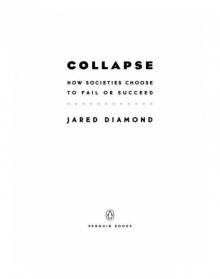 Collapse: How Societies Choose to Fail or Succeed
Collapse: How Societies Choose to Fail or Succeed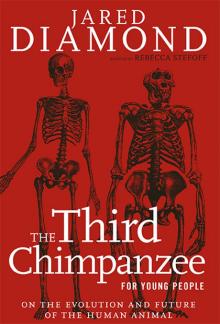 The Third Chimpanzee: The Evolution and Future of the Human Animal
The Third Chimpanzee: The Evolution and Future of the Human Animal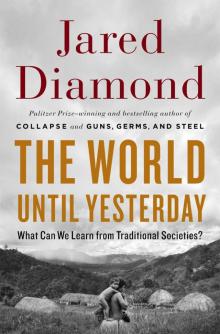 The World Until Yesterday: What Can We Learn From Traditional Societies?
The World Until Yesterday: What Can We Learn From Traditional Societies?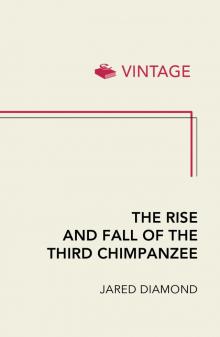 The Rise and Fall of the Third Chimpanzee
The Rise and Fall of the Third Chimpanzee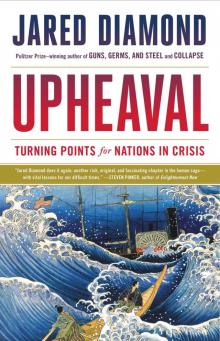 Upheaval: Turning Points for Nations in Crisis
Upheaval: Turning Points for Nations in Crisis Guns, Germs, and Steel
Guns, Germs, and Steel The Third Chimpanzee for Young People
The Third Chimpanzee for Young People Why Is Sex Fun?
Why Is Sex Fun?